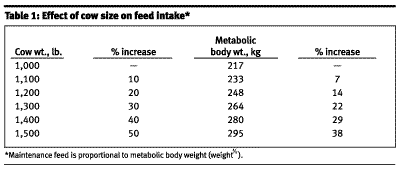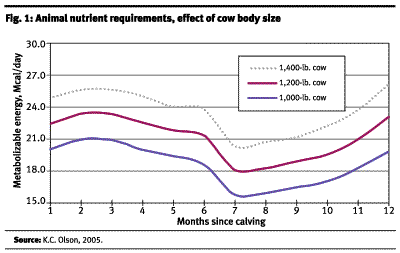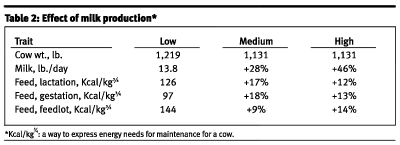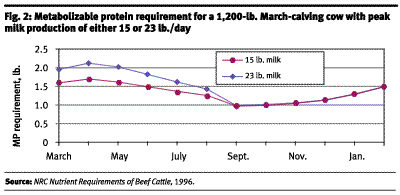
Rick Rasby
Ridin’ Herd
What size fits?
With high input costs, cattle producers continually refine and evaluate how resources are being allocated. Because feed costs make up the largest portion of annual cow costs, producers look to attack feed costs to make their livestock enterprise competitive. As producers re-evaluate feed inputs, revisiting items that drive nutrient needs of beef cows is a good first step.
Beef cattle geneticists make the statement that cow type needs to fit the feed resource of your operation and that different biological types fit better in high-stress and low-stress environments. Feed resources differ from ranch to ranch, and not all cow types will excel in a particular production system.
What drives nutrient requirements?
The 1996 National Research Council (NRC) Nutrient Requirements of Beef Cattle is considered the bible for nutrient needs. Nutrient requirements for beef cows are affected by cow age (first-calf cows vs. mature cows), weight/size, lactation ability (breed type), stage of production (gestating vs. lactating), environmental conditions, and body condition of the female.
Managing for milk levels in your cow herd is kind of like determining whether the porridge is too cold, too hot or just right.The 1996 NRC guidelines allow for adjustments for cows that are in different body condition. The body condition
scoring system used is the 1-to-9 scale, where 1 is thin and emaciated and 9 is fat and obese.
The 1996 NRC will adjust nutrient needs for different environmental temperatures. For beef cows, the question is: How do you manage a cow herd when a sustained number of days are well below their lower critical temperature? In some situations, not enough feed can be fed or intake is not high enough to really meet their nutrient needs. These situations are why managing body condition is so critical and why it should be used as a risk management tool.
Finally, the increase in nutrient needs of young cows vs. mature cows is primarily due to the growth requirement of young cows.
Impact of cow weight
Maintenance feed intake is proportional to metabolic body weight, which is described as body weight to the ¾ power (body wt.¾). Metabolic body weight isn't just weight of the animal but also describes the surface area of the animal. Cows that weigh 1,300 pounds (lb.) have a greater nutrient [pounds of protein, pounds of energy (TDN), ounces of mineral, etc.] requirement compared to cows that weigh 1,000 lb. If a 1,000-lb. cow and a 1,300-lb. cow are grazing the same forage resource, the 1,300-lb. cow will need to consume more of that forage to meet her requirements.
Heavier cows eat more feed to meet their requirements. The question is: How much more do heavier cows eat? Table 1 (metabolic body weight is expressed in kilograms) suggests that for each 10% increase in body weight, there is not a 10% increase in maintenance feed intake. The data suggest about a 7% increase in feed intake for each 10% increase in live weight. A 1,300-lb. cow will consume 22% more feed than the 1,000-lb. female, although there is a 30% difference in body weight. To present this concept a little differently, Fig. 1 illustrates changes in energy needed for cows that weigh 1,400, 1,200 and 1,000 lb. as they progress from calving to their next calving. The energy needs would be of cows of similar milk potential. Peak lactation would occur about 60-80 days postcalving.
The difference between the 1,400-lb. cow and the 1,000-lb. cow is about 5.1 megacalories (Mcal) per day. Native hay is about 0.78 Mcal per lb., so that's about a 6.5-lb. difference in hay intake between the 1,000-lb. cow and the 1,400-lb. cow on a dry-matter (DM) basis. If the hay is 88% DM and costs $65 per ton, that calculates to $0.24 per day difference.
Illustrated another way, if a 1,000-lb. cow with a calf at her side is 1 animal unit month (AUM; consumes 26 lb. per day forage DM), then the 1,400-lb. cow is 1.4 AUMs. The difference is 0.4 AUMs, and you can calculate the number of cow-calf pairs you can graze on the same pasture resource.
Milk levels
Managing for milk level in your cow herd is kind of like determining whether the porridge is too cold, too hot or just right. Too little milk in the cow herd equates to lighter weaning weights, which affects dollars generated in the cow-calf enterprise. However, low milk level in a cow herd should result in lower feed costs. High milk level equates to heavier weaning weights, but also has the potential to increase feed inputs and therefore cow costs.
As milk potential increases, so does nutrient need. Cows that have a high milk level have a greater need for daily protein, TDN, mineral, etc., compared to cows with a low level of milk potential.
A number of years ago at the University of Nebraska, three groups of cows were developed that were similar in weight, but differed in level of milk produced (see Table 2). The cows in the moderate-milk group gave 28% more milk than the cows in the low-milk group. The cows in the high-milk group gave 46% more milk than cows in the low-milk group.
As one would expect, the feed for lactation between the three groups differed, with cows in the moderate- and high-milk groups needing more feed to stay in similar weight and body condition as compared to cows in the low-milk group.
Even more interesting is that feed during gestation was greater for cows in the moderate- and high-milk groups compared to cows in the low-milk group, indicating that even when the cows with different milk-producing abilities were not lactating, milk potential increased nutrient needs.
In addition, feed needed in the feedlot was greater for offspring from dams that had higher milk potential. Data from the Roman L. Hruska U.S. Meat Animal Research Center (USMARC) at Clay Center, Neb., indicate that cows with greater potential to produce milk also have a greater percent of their body weight as heart, liver and lungs. So the greater nutrient need for nonlactating cows and for their offspring in the feedlot may be a result of having to maintain more weight in visceral organs, which are highly active tissues.
Fig. 2 illustrates the difference in metabolizable protein between cows that have the potential to produce different levels of milk. Early in the lactation curve, there is about 0.5 lb. difference in MP (metabolizable protein) requirement. That 0.5-lb. difference in MP narrows toward the end of the lactation curve.
If cattle are asked to produce in a lush environment, then cow mature weight and level of milk is less of a concern except that carrying capacity will be reduced. If feed resources are limited, cow weight and milk production need to be carefully scrutinized.
Summary
Cow weight and milk level affect not only nutrient requirements, but also feed intake. The focus of this article is not that we need smaller cows, but to point out items that have a big effect on the nutrient needs of beef cows, mainly cow weight and level of milk production.
 From an economic standpoint, the greater number of cows that can be grazed on a given forage base, meeting their nutrient needs from the grazed resource base, the greater the profit potential of the enterprise. From a commercial cow-calf perspective, it may be wise to avoid extremes in size and milk production, include cow maintenance expected progeny differences (EPDs) as a part of your bull selection criteria, and adjust calving and weaning dates to manage body condition.
From an economic standpoint, the greater number of cows that can be grazed on a given forage base, meeting their nutrient needs from the grazed resource base, the greater the profit potential of the enterprise. From a commercial cow-calf perspective, it may be wise to avoid extremes in size and milk production, include cow maintenance expected progeny differences (EPDs) as a part of your bull selection criteria, and adjust calving and weaning dates to manage body condition.
The American Angus Association provides an online resource, the Optimal Milk Module, to help producers determine the optimum milk EPDs for their herds. To access the module, visit www.angus.org/Performance/OptimalMilk/OptimalMilkMain.aspx.
[Click here to go to the top of the page.]

















